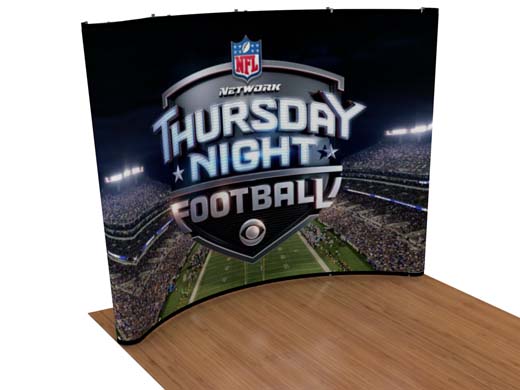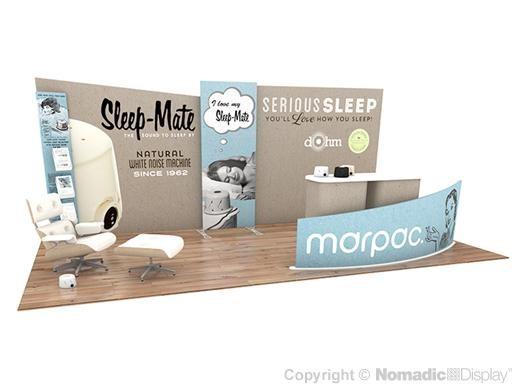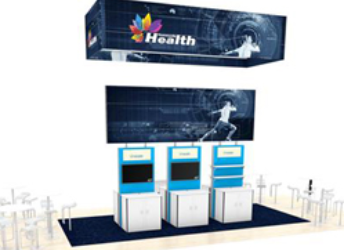Trade show budgets are a balancing act.
You want visibility. You want strong leads. You want to show up like a serious brand. But when you start running the numbers, the decisions get tricky fast.
Do you go all in on one major industry show with a high-traffic 20x20 island space and bold design? Or do you take the same budget and hit three or four smaller shows, using a portable display that reconfigures to fit different footprints?
On paper, both strategies have merit. But what’s the right move for your team, your brand, and your goals?
That’s where exhibitors tend to get stuck. Not because they don’t know their business, but because trade shows aren’t a one-size-fits-all equation. You’re constantly weighing:
- Cost of space versus value of exposure
- Quantity of leads versus quality of engagement
- Brand visibility versus operational flexibility
- Size of your footprint versus size of your follow-through
Add to that a team with limited time, a long list of events, and a need to justify every dollar, and the pressure only builds. It’s not just about attending a show anymore. It’s about making the right call — because one misstep can burn through your entire year’s budget without delivering the return.
This blog lays out the real numbers, the trade-offs, and the decision-making criteria we’ve seen work best over decades of helping exhibitors make the most of their programs.
If you’re trying to figure out how far your budget can go — and which shows to bet on — this is for you.
Understanding where your budget actually goes
Let’s start with the costs. Not the sticker price for floor space, but the full-picture reality of what trade shows require.
Option A – One large 20x20 island exhibit at a major show
| Line Item |
Estimated Cost |
| Exhibit space (400 sqft) |
$25,000 |
| Custom island exhibit |
$55,000 |
| Drayage and shipping |
$10,000 |
| Labor and I&D |
$12,000 |
| Travel and hotel |
$10,000 |
| Promotions and lead capture |
$5,000 |
| Total
|
$117,000 |
Option B – One reconfigurable 10x20 system used at 3–4 shows
| Line Item |
Estimated Cost |
| Exhibit space (3x 10x10 and 1x 10x20) |
$18,000 |
| Portable modular exhibit (reconfigurable 10x20) |
$25,000 |
| Drayage and shipping |
$4,000 |
| Labor and I&D |
$0 |
| Travel and hotel |
$5,000 |
| Promotions and lead capture |
$5,000 |
| Total
|
$73,000 |
That’s a $44,000 difference, while reaching more locations, more audiences, and more events.
And the $25,000 exhibit you invested in? It’s yours to keep, reuse, and reconfigure again next year. Or simply update the graphics with a brand new message.
What you gain by showing up more often
There’s a big difference between being remembered and being recognized.
When you exhibit just once a year, even at a major event, you risk being a one-time visual. But when your brand shows up consistently — regionally, nationally, or across specific verticals — you build familiarity that sticks.
Research backs that up:
- The average B2B buyer needs 8 or more touchpoints before taking action
- Trade show leads cost 38% less than traditional sales calls
- Repeat exposure improves brand recall and trust by over 70%
In other words, it’s not just the size of your display that matters. It’s the number of qualified impressions you can make, and how well you support those with strategic conversations and solid follow-up.
Three or four well-targeted shows with a reconfigurable display system can often generate better returns than a single high-investment appearance especially when those shows reach distinct audiences or regional buyers you wouldn’t otherwise see.
When one large exhibit can make the difference
That said, there are times when a larger footprint isn’t just a visual statement — it’s a strategic one.
You may benefit from a 20x20 island if:
- You’re launching a product that needs space for live demos
- You’re hosting scheduled meetings with clients, press, or distributors
- Your competitors are investing heavily in presence and placement
- You need to own the space, rather than blend in
Larger exhibits offer more flexibility for design, storytelling, and layout. You can separate engagement zones from private areas, control the sightlines from every approach, and integrate technology in a more immersive way.
If your team is staffed to manage high traffic and you’ve got a strong lead capture and nurture plan in place, a large booth at a flagship show can absolutely justify its cost.
When smaller shows carry more strategic weight
If you’re testing a new market, expanding into niche verticals, or working with a leaner team, then a multi-show strategy can offer more impact with less risk.
By using a reconfigurable 10x20 exhibit that breaks into two 10x10s, you can scale your presence based on the size of the show, the strength of your audience, and your current goals.
Smaller events also tend to offer:
- Easier logistics
- Lower total spend per lead
- Less competition for attention
- More opportunity for direct conversation
And the return? Often higher.
Especially when you factor in staff energy, time available per conversation, and the ability to attend multiple shows within the same quarter, using the same system.
Industries that benefit most from a multi-show strategy
Not every industry is built around one major event. Some perform better with a presence at multiple smaller shows throughout the year.
Here are just a few where a flexible, portable strategy offers clear advantages:
Healthcare and medical devices
These markets are segmented by specialty, with dozens of mid-sized regional or vertical shows across orthopedics, radiology, dental, and more. Exhibitors often get better ROI by focusing on several smaller events with a clear buyer profile.
Education and training
Most purchasing happens at the state or district level. Reaching decision-makers often means attending multiple local or state-led conferences, where a large footprint isn’t required — but being present is.
Specialty food and beverage
From natural foods to regional distribution expos, this space thrives on exposure and repeat sampling. Multiple events allow brands to meet different buyers in different regions and maintain product visibility.
Tech startups and SaaS companies
These teams need to test messages, reach specific user groups, and pivot fast. Smaller shows let them have deeper conversations without the noise of a massive expo and modular displays help them keep up with fast-changing product releases.
Associations and nonprofits
Often working with tight budgets, these organizations rely on reusable, flexible systems they can take to annual conferences, recruiting fairs, and community expos without overspending.
If you're in one of these sectors or operate like them, then a modular portable system isn't just a good option. It’s likely the best one.
Choosing the right shows matters more than choosing a footprint
No matter which route you take, one of the biggest ROI killers is simply picking the wrong event.
Before you commit your team, budget, and exhibit, ask:
Who actually attends?
Ask for attendee lists, industries, and titles. Look beyond the overall headcount. You’re not looking for warm bodies, you’re looking for decision-makers, budget owners, and true buyers.
How has attendance trended over the last 3 years?
If the show used to draw 20,000 and now struggles to pull 8,000, you need to know that. Ask the organizer for hard numbers or connect with past exhibitors to get a real read.
Are your top competitors or peers exhibiting?
If your key competitors or customers are present, chances are good the audience is aligned with your goals. If your space is sandwiched between unrelated industries, it may not be the best fit.
Is the format flexible?
Can you start with a 10x10 this year and expand to a 10x20 or larger later? Are there upgrade options for corner spaces, tech add-ons, or shared visibility packages?
Are exhibitors returning year after year?
Retention is a great sign. If brands are coming back, that usually means ROI is there even if it’s not always visible in the marketing materials.
When in doubt, visit the show before you exhibit. Walk the floor. Attend the sessions. Talk to other vendors. If it feels like the right energy and the right audience, you’ll know.
Invest once and multiply the return
If you’re going to spend five or six figures on trade shows this year, the question isn’t just where to go, it’s how to make every part of that investment work harder.
A reconfigurable exhibit system gives you options most teams overlook:
- Use it as a 10x20 one week and split it into two 10x10s the next
- Adjust for regional events, vertical audiences, or quick-turn schedules
- Add new graphics or counters without replacing the entire build
- Stay consistent in your brand without being stuck in one format
The result isn’t just flexibility—it’s efficiency. It’s how you get more reach, more engagement, and more measurable outcomes without buying new every time the calendar shifts.
When you have an exhibit that can do more, your entire program gets sharper. Planning becomes easier. Budgets go further. And strategy finally drives the structure, not the other way around.
If you're ready to streamline and scale with intention, ask us about our Portable Modular Program. It’s built for teams who want to get more from every show—without starting over every time.
As you plan your next move, now’s a good time to explore your options, select portable and modular displays are currently 10% off. Shop Now.





